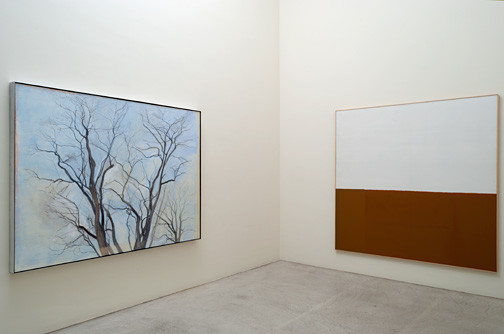The Skin of Painting
26 Oct 2013 - 01 Feb 2014
THE SKIN OF PAINTING
James Bishop, Antonio Calderara, Joseph Egan, Richard Francisco, Robert Mangold, Sylvia Plimack-Mangold, Jerry Zeniuk, Sol LeWitt
26 October 2013 - 1 February 2014
Placing the paintings of this exhibition in a context of correlations and references would belie the intention of the exhibition, which also informs the decision to forego a list of artists. The exhibition title draws attention to the fact that overlooking is a factor of looking and seeing, that what is actually there often fails to get a word in edgewise and the interpretation sets in on a level that invisibilizes the experiencable presence of the painterly properties of the artifact through disregard and non-observance, unless the color matter blaringly calls attention to itself.
With its featured works, however, our exhibition by no means intends to illustrate the superficial orchestration of color and application of paint, or even the process of painting. The much more mysterious epidermis, the boundary between body and world, is the aim. A curious corporeal analogism has accompanied the Western painterly tradition as the skin of painting, traces of which remain evident up to the present. The surfaces of paintings embody division and unity of touch and untouchability, of the intelligible and the sensible, of intellect and sensuality. These contrasts mirror an overpowering topos of the dualistic tradition of Western philosophy, namely the opposition of intellect and sensuality.
The diverse properties of pictorial surfaces lent these expressive power and intrinsic value from the nineteenth century up through the modernist era. The closure or openness, brittleness or suppleness, transparency or density of the painted surfaces are an important and integrated element of the aesthetic function (Jan Mukařovský) and the perceptual structure offered by the works.
Around 1960, a moderate foreboding of a radical change in image production began to become evident. The silkscreen was still utilized by a number of artists in the context of painterly diction. With the use of photographic techniques in the production of artifacts and later with the application of digital technologies, the paintings have increasingly lost their discrete and self-accordant skin. This dramatic loss of essence and presence of the artifact moreover leads to a disregard of a quality which nothing else has managed to outweigh and yet is nevertheless classified in the current art discourse as an anachronistic remnant and scarcely given any consideration.
The paintings in our exhibition show that any talk of an obituary for an outmoded cultural good which has lost its raison d’être is much too premature. The conveyance of the value and comprehensibility of our theme can hardly be overestimated, as the body of paintings from throughout art history does not consist of immaterial signs and signals, but of “aesthetic objects which become concrete and undergo their individual realization in the consciousness of the receiving subject.” (Jan Mukařovský)
James Bishop, Antonio Calderara, Joseph Egan, Richard Francisco, Robert Mangold, Sylvia Plimack-Mangold, Jerry Zeniuk, Sol LeWitt
26 October 2013 - 1 February 2014
Placing the paintings of this exhibition in a context of correlations and references would belie the intention of the exhibition, which also informs the decision to forego a list of artists. The exhibition title draws attention to the fact that overlooking is a factor of looking and seeing, that what is actually there often fails to get a word in edgewise and the interpretation sets in on a level that invisibilizes the experiencable presence of the painterly properties of the artifact through disregard and non-observance, unless the color matter blaringly calls attention to itself.
With its featured works, however, our exhibition by no means intends to illustrate the superficial orchestration of color and application of paint, or even the process of painting. The much more mysterious epidermis, the boundary between body and world, is the aim. A curious corporeal analogism has accompanied the Western painterly tradition as the skin of painting, traces of which remain evident up to the present. The surfaces of paintings embody division and unity of touch and untouchability, of the intelligible and the sensible, of intellect and sensuality. These contrasts mirror an overpowering topos of the dualistic tradition of Western philosophy, namely the opposition of intellect and sensuality.
The diverse properties of pictorial surfaces lent these expressive power and intrinsic value from the nineteenth century up through the modernist era. The closure or openness, brittleness or suppleness, transparency or density of the painted surfaces are an important and integrated element of the aesthetic function (Jan Mukařovský) and the perceptual structure offered by the works.
Around 1960, a moderate foreboding of a radical change in image production began to become evident. The silkscreen was still utilized by a number of artists in the context of painterly diction. With the use of photographic techniques in the production of artifacts and later with the application of digital technologies, the paintings have increasingly lost their discrete and self-accordant skin. This dramatic loss of essence and presence of the artifact moreover leads to a disregard of a quality which nothing else has managed to outweigh and yet is nevertheless classified in the current art discourse as an anachronistic remnant and scarcely given any consideration.
The paintings in our exhibition show that any talk of an obituary for an outmoded cultural good which has lost its raison d’être is much too premature. The conveyance of the value and comprehensibility of our theme can hardly be overestimated, as the body of paintings from throughout art history does not consist of immaterial signs and signals, but of “aesthetic objects which become concrete and undergo their individual realization in the consciousness of the receiving subject.” (Jan Mukařovský)

